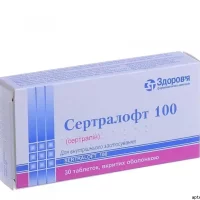$51.20
Manufacturer: Ukraine
Purpose: Selective serotonin reuptake inhibitor for treating depression and anxiety disorders.
Description
Escitam (escitalopram) 20 Coated Tablets 20 mg. №30
Ingredients:
Each tablet contains 20 mg of escitalopram as the active ingredient. Other ingredients include lactose monohydrate, microcrystalline cellulose, colloidal anhydrous silica, croscarmellose sodium, and magnesium stearate.
Dosage:
The recommended dosage is one 20 mg tablet daily. It is important to follow the instructions provided by your healthcare provider for the best results.
Indications:
Escitam tablets are indicated for the treatment of major depressive disorder and generalized anxiety disorder. It works by restoring the balance of certain natural substances in the brain.
Contraindications:
Do not use Escitam if you are allergic to escitalopram or if you are taking monoamine oxidase inhibitors (MAOIs). It is important to consult your doctor before starting this medication.
Directions:
Take one tablet orally with or without food, usually once daily in the morning or evening. Swallow the tablet whole with a glass of water. Do not crush or chew the tablet.
Scientific Evidence:
Escitalopram, the active ingredient in Escitam tablets, is a selective serotonin reuptake inhibitor (SSRI) that has been extensively studied for its efficacy in treating depression and anxiety disorders. Clinical trials have shown that escitalopram is effective in improving symptoms of depression and anxiety compared to a placebo.
One study published in the Journal of Clinical Psychiatry found that escitalopram was significantly more effective than placebo in reducing symptoms of generalized anxiety disorder. The study concluded that escitalopram is a safe and effective treatment option for patients with this condition.
Additional Information:
- Storage: Store at room temperature away from light and moisture.
- Side Effects: Common side effects may include nausea, dry mouth, drowsiness, or insomnia.
- Precautions: Inform your doctor about any other medications you are taking before starting Escitam.







Recent Reviews